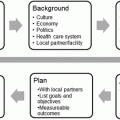© Springer Science+Business Media New York 2014
Daniel J. Mollura and Matthew P. Lungren (eds.)Radiology in Global Health10.1007/978-1-4614-0604-4_1717. Interventional Procedures for Global Health Radiology
(1)
Division of Vascular and Interventional Radiology, Johns Hopkins University, 1800 Orleans St., Zayed Tower Suite 7203, Baltimore, MD 21287, USA
(2)
Department of Radiology, Duke University, 2301 Erwin Road, Durham, NC 27713, USA
Introduction
While the impact of diagnostic imaging has revolutionized modern medicine, its availability in developing countries is often limited, of reduced quality, or nonexistent [1]. Paralleling the importance of imaging to diagnosis, the evolution of minimally invasive interventional radiological procedures has allowed these often lifesaving therapies to minimize or obviate the need for highly morbid open surgeries. However, while the challenges of modernizing diagnostic imaging capabilities in poorly developed nations are great, there is little doubt that the hurdles that must be overcome to safely and practically implement technologically demanding interventional radiological procedures are even greater.
This chapter will discuss the financial and intellectual challenges involved in establishing effective interventional radiology (IR) service in developing countries, as well as outline practical approaches to current IR techniques that may make them more accessible to technologically devoid counties. It is expected that with emerging interest in and ability to provide minimally invasive therapies to a wider global population, many of the challenges addressed below will be overcome, while others will be newly discovered. However, with the generosity and dedication of interventionalists and colleagues all over the world, even the seemingly most insurmountable obstacles can be overcome. The ultimate goal is to provide the best care to even our most vulnerable patients.
The Cost-Effective Approach
The equipment used by interventional radiologists for diagnosing and treating patients is capital-intensive. While the subspecialty is highly technical, innovative, and integral to modern medical management, a healthy perspective must be used to determine exactly what role interventional radiological procedures can play in limited-resource countries. For help in achieving that perspective, one has only to review the mission of the World Health Organization (WHO), the United Nations agency that provides guidance on health policy and resource allocation for improving the quality of human life worldwide. The WHO acts as broker and arbiter, helping shape the rules of engagement between government, development agencies, and civil society in promoting equitable and sustainable health for all.
In bringing radiology services to countries where resources are limited, the WHO has stated that the majority and most marginalized should be prioritized. In the WHO estimates, roughly 90 % of countries with basic or no medical care access would, in terms of radiology services, benefit most by standard plain film radiography and ultrasound. The remaining patients who would benefit from the more advanced and expensive equipment are given a lower priority for resource allocation. In fact, the WHO recommends that fluoroscopy, CT, angiography, MRI, nuclear medicine, and advanced ultrasound should not be installed unless radiologists and fully trained technologists are present at the facility to use it. Paradoxically, very expensive imaging equipment is often seen in hospitals that lack even the most basic healthcare essentials such as chest tubes, cardiac monitors, pulse oximeters, drugs, staplers, suture material, gloves, and lubricating gel. In many of these instances, the root cause can often be traced to political corruption, resource misallocation, or ill-prepared outreach and donation efforts.
The WHO recommends that imaging equipment in low-income regions be “available, accessible, appropriate and affordable,” as stated in their 2010 publication Medical Devices: Managing the Mismatch. This report points out that medical devices may not be adapted to withstand hot and dusty climates and may not run on the insufficient electricity supplies of low-income settings. Generators break down, equipment does not get serviced, and there are no service engineers in the country. An engineer may have to be flown in, put up in a hotel, and replacement parts ordered that may take months to arrive. Sometimes, even if the representative is present, there may not be a full service and maintenance contract between manufacturers, suppliers, or maintenance companies with the users; this disconnect leads to long periods of inactivity and frustration.
Furthermore, one must consider the expense of the traditionally disposable tools required to perform interventional procedures. Although the expense of items such as catheters, needles, and wires may seem minor at first, their cumulative expense may prove to be a powerful obstacle to the ongoing functioning of an interventional radiology lab. One of the more obvious—and common—ways to mitigate this hurdle is to recycle and reuse interventional tools [2, 3]. While the safety of this practice is controversial, in many centers worldwide, this option is necessary and routine. The main concerns rest not only on the risk of infectious complications from catheter reuse but also on the risk of instrument malfunction and fracture; again, the impact and frequency of these complications are uncertain. Some centers will screen patients for human immunodeficiency virus (HIV) and viral hepatitis, disposing of the instruments in those cases when the patient tests positive [4]. One pediatric cardiology catheterization lab in India has described >32,000 catheterization procedures with no cases of procedural-related sepsis or endocarditis; though the center did report occasional catheter breakage, fragments were successfully snared [3].
Interventional Radiology Training and Education
Meeting the financial requirements of image-guided interventions is arguably less of a challenge than satisfying the intellectual requirements. Unlike diagnostic radiology, in which telemedicine allows for “outsourcing” practitioners competent in the imaging interpretation, minimally invasive procedures demand that a skilled provider be physically present. Though medical volunteerism and international health rotations may provide interventionalists from other parts of the world, their numbers are insufficient to match global demand; effective training of local providers should be the ultimate goal in establishing an IR practice.
In a perspective essay on overseas medical experience, Henderson [6] delineates the moral dilemmas that may arise in impoverished nations:
However, clinical moral dilemmas remain: do we give life-saving blood known to be contaminated by hepatitis B? Do we re-use a spinal needle as it is the only one available and the child, if not the mother, will die without a Cesarean section? Do we give the Taliban a sterile surgical set to cut off hands of thieves? [6]
These scenarios present real challenges and are often unique to the procedural radiologist in developing countries; the overseas interventionalist is likely not only unaccustomed to such problems but also may be unaware of their existence and untrained to handle them. A dedicated training program involving domestic experts should consider these issues and train staff appropriately. Along the same lines of ethical concern is the involvement of first world trained trainees—residents and fellows—occupying a trainer role in the developing world [8]. It is essential that good intentions do not lead to medical malfeasance, teaching trainees that international patients do not require or deserve the same attending level care than do patients back at home [8]. The argument that “desperate times call for desperate measures”—that is, offering some physicians with some level of training is better than not having training for physicians at all—may be true due to the lack of resources in developing world healthcare systems. The constrained resources further limit the ability of the physician to manage iatrogenic or avoidable complications, and thus necessitate optimal medical care being delivered on first attempt [9]. However, with appropriate supervision, critical appraisal of resident or fellow skills, managed expectations, and well-delineated guidelines, domestic trainees can help initiate and support a developing interventional service overseas.
A newer option emerging for training—both domestically and abroad—exploits the great technological advancements in medical simulation training. In a procedure-based specialty such as interventional radiology, there is little substitute for experience; however, the opportunities for an interventionalist to practice his or her skills are far less readily available than for our diagnostic colleagues, who can review vast teaching files to test their abilities. Simulators may play an expanding role in procedural training both domestically and in resource-restricted areas as computer technology is becoming more accessible worldwide. Simulators may be model-based, computer-based, or a hybrid; while model-based simulators may be inexpensive, there is usually little objective feedback that can be provided from the model [10]. The hybrid-type simulator can combine physical models with a computerized interface to allow for a more robust, tailored, and interactive experience [11]. Recently, the concept of telesimulation was introduced by Canadian physicians in order to teach laparoscopy to African surgeons [11]. This distance learning technique relies on the computerized linking of medical simulators at the trainers’ and the trainees’ sites and relies on computer videoconferencing for didactic communication. This novel technique utilizing the most advanced pedagogical tools in a relatively low-resource manner has been shown to be effective in increasing the trainee proceduralist’s confidence, comfort level, and skill in performing procedures [11, 12].
Once the decision has been made to train providers from developing countries, one must choose the types of procedures that warrant exportation and the skill level of the trainee required to perform them. Surgical operations may be categorized according to the extent of training required: operations within the competence of any qualified doctor or physician extender, operations that could be performed by a doctor or physician extender specifically trained for the procedure, operations normally performed by someone with higher qualifications and training, or operations that require subspecialty training beyond the scope of the general surgeon [13]. A similar organization hierarchy may be applied for interventional procedures, ranging from paracentesis to transjugular intrahepatic portosystemic shunt or complex embolization procedures. This way, educational resources may be distributed more efficiently and practically. Practitioners in very rural settings may gain expertise and resources to perform medically necessary procedures with lower skill level requirements and leave the more difficult procedure training to the hospitals in relatively major centers who can “fly solo” with regular support from abroad [5, 13].
A final consideration critical to the implementation of an interventional radiology training program in developing nations is periprocedural care. In the USA, the shift away from the interventional radiologist as an isolated proceduralist relegating medical care of the patient to referring physicians has largely been accepted as necessary, inevitable, and appropriate [14]. While the reasons for this paradigm change in the USA are multifactorial, this model of the interventional radiologist as clinician may be even more important in a resource-scarce area. Given the potential for the infusion of locally novel, minimally invasive procedures into a healthcare system unfamiliar with the equipment used, the procedure itself, or the periprocedural medical care needed, the foreign interventionalist occupies the most appropriate role to be proficient in all these areas rather than relying on local medical colleagues. In fact, interventional radiology programs that have recently emerged outside of the Western world have already begun embracing this concept, allowing the interventionalist to assume care for the entirety of periprocedural care and follow-up [15].
Beyond redesigning training programs, there have been many innovations to modify how procedural treatments are both accessed and conducted. The need for creativity to limit resource requirement is essential to the development of an economically feasible interventional radiology service in the developing world. It is crucial to reevaluate the necessity of the technologies and techniques that have become standard in developed nations. For instance, whereas percutaneous nephrostomy for obstructive uropathy is typically performed with needle, wire, dilator, and catheter, the feasibility of a direct puncture technique using only a low-cost trocar catheter drainage set has been reported with good outcome, eliminating the need for additional equipment at additional expense [16]. Reports describing gastrostomy tube placement, foreign body retrieval, and vascular malformation treatment under ultrasound guidance provide a few examples of therapies that may be offered without the traditional technological demands of fluoroscopy [17–19]. Additionally, there exist some procedures conventionally outside the scope of the interventional radiologist that may be introduced to an area with ultrasound capabilities: ultrasound-guided incarcerated hernia reduction represents such an intervention [20]. Other diseases for which the proceduralist traditionally offers image-guided therapy may be replaced completely with medical management, as in tPA for cerebrovascular accident [21].
Innovative Strategies for Interventional Radiology Outreach
As noted above, a relative lack of resources and expertise can make translating the practice of interventional radiology in the developed world to the underdeveloped world very difficult. The purpose of this section is to look at ways interventional radiology has been applied in a resource-constrained environment and understand how that can be translated to the developing world.
Fluoroscopically Guided Interventional Radiology
Return on investment analyses have quantified the value of these services in terms of quality-adjusted life years saved and avoidance of other medical expenses [23]. In an extraordinary initiative by Drs. Nestor Kisilevzky and Henrique Elkis, uterine artery embolization was offered to women in underserved, impoverished areas of Brazil using a portable C-arm, and necessary supplies were loaded on a truck and delivered on rotation to four public hospitals [22]. They used a small truck to transport a mobile C-arm and angiographic supplies rotating among four hospitals every week for a total of 6 weeks. All equipment and supplies were moved into either an operative suite or obstetric suite in the hospitals in order to protect them from damage. They were able to achieve fluoroscopic times within an acceptable range, and outcomes and complications were similar to published results from conventional facilities. While these authors reported that all embolizations were performed under epidural anesthesia without complications, those wishing to treat patients with the help of local operating room staff should do so with caution.
Stay updated, free articles. Join our Telegram channel

Full access? Get Clinical Tree






